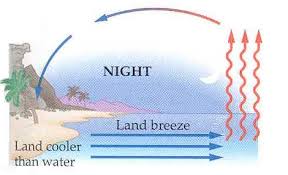
Understanding Land Breeze
Here's a great article by Captain Bob Figular for the Mariners Learning System about the often misunderstood land breezes.
The opposite of a sea breeze is a land breeze. While sea breezes occur during the day, land breezes occur at night. Despite the difference in times at which the land breezes and sea breezes occur, the reason for the land breeze’s formation is the same as the sea breeze, just the role of the ocean and land is reversed.
Land breezes can occur when the land’s nighttime temperature is less than the sea surface temperature. They are most common during the fall and winter seasons when water temperatures are still fairly warm and nights are cool. However, unlike the sea breeze, the land breeze is usually weaker.
At night, the land temperature falls to below that of the ocean and becomes less dense. Therefore it begins to rise. The rising air creates a weak low-pressure area due to a decrease in air mass at the surface. As the air-cools, it begins to collect resulting in an increase in pressure, creating a “high”.
These differences in pressures over the water, both at the surface and aloft are greater than the differences in pressures over land at the same elevations over the water. Therefore, as the atmosphere seeks to reestablish equal pressure both onshore and offshore, two high-pressure to low pressure airflows develop; the onshore flow aloft and surface offshore flow, called the land breeze.
Land breezes are weaker than sea breezes but not because of the difference in heating. Daytime heating and nighttime cooling occur at about the same rate so the potential for the both land and sea breezes to be the same strength exist.
But at night the cooling ground inhibits vertical motion that, in turn, weakens the land breeze circulation, Nighttime cooling also produces a shallower change in temperature so land breeze circulation is shallower, and terrain, vegetation, and buildings inhibit the flow of air from land to water.